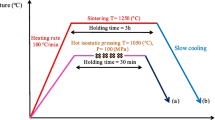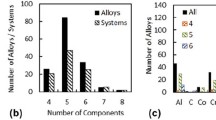Statistical studies of the chemical composition (alloying element and impurity contents, aluminum and molybdenum equivalents), polymorphic transformation temperature, structure (globular, lamellar, transition, mixed, basket-weave), and standard mechanical properties (tensile strength, elongation, reduction of area, impact strength, hardness) of rolled bars 15–150 mm in diameter, prepared from titanium alloy VT6 in 2013–2017 are performed. Various types of structure are obtained by changing deformation regime and simple annealing (600–920°С, 20–180 min, air cooling). Correlation relationships of mechanical properties with various factors are analyzed. It is established that the mechanical properties of bars with globular, transitional, and mixed structures are more dependent on fluctuations in grade composition and annealing regime than on the type of structure. Multivariant regression dependences are proposed for evaluating mechanical properties from alloying element and impurity equivalents for aluminum and molybdenum, the difference between polymorphic transformation and annealing temperatures, annealing time, and bar diameter.





Similar content being viewed by others
References
N. Saunders, X. Li, A. P. Miodownik, and J.-P. Schille, “An Integrated Approach to the Calculation of Materials Properties for Titanium Alloys,” in: Titanium — 2003: Titanium Science and Technology, Hamburg (2003), pp. 1397–1404.
A. Sidorov, “JMatPro — software for monitoring steel and alloy properties,” Instrumenty ARM, 2–4 (2015).
O. M. Ogorodnikova, Consolidated Computer Analysis of Processes for Preparing and Operating Metallic Materials in Engineering, Diss. Doc. Techn. Sci., Ekaterinburg (2015).
J. Hill, G. Mulholland, K. Persson, et al., “Materials science with large-scale data and informatics: Unlocking new opportunities,” MRS Bulletin, 41, No. 5, 399–409 (2016).
A. A. Il’in, B. A. Kolachev, and I. S, Pol’kin, Titanium Alloys, Structure and Properties: Handbook [in Russian[, VILS MATI, Moscow (2009).
E. A. Borisova, et al., Titanium Alloys. Titanium Alloy Metallography [in Russian], Metallurgia, Moscow (1980)
S. P. Belov, M. Ya. Brun, S. G. Glazunov, et al., Metallography of Titanium and its Alloys [in Russian], Metallurgiya, Moscow (1992).
V. G. Lazarev and T. K. Polyakova, “Evaluation of the polymorphic transformation temperature for titanium alloys according to chemical composition,” Tsvet. Met., No. 3, 86–87 (1982).
D. Furrer, A. Chatterjee, G. Shen, A. Woodfield, et al., “Development and application of microstructure and mechanical property models for titanium alloys,” in: Titanium’2007: Science and Technology: Рroc. 11th World Conference on Titanium (Kyoto, Japan, 3–7 June 2007), Vol. 1 (2007), pp. 781–784.
B. A. Kolachev, Yu. S. Eliseev, A. G. Bratukhin, and V. D. Talalaev, Titanium Alloys ad Structures in the Production of Aero Engines and Aerospace Technology [in Russian], Izd. MAI, Moscow (2001).
V. V. Svael’ev, A. D. Chuchuryukin, Yu. M. Prilutskikh, et al., “Study of the stability of polymorphic transformation temperature in industrial ingots of alloy VT3–1,” TLS, No. 5, 28–31 (1984).
H. Onodera, Y. Ro, T. Yamagata, and M. Yamazaki, “Design of titanium alloys, Titanium-84,” Titanium Science and Technology, Munich (1984).
V. M. Vozdvizhenskii, M. V. Vozdizhenskaya, and E. E. Il’in, “Use of method of derived concentrations for calculating titanium alloy characteristics and properties,” Tsvet. Met., No. 1, 56–59 (1999).
S. G. Glazunov, A. F. Matveenko, and Yu. M. Dolzhanskii, “Study of statistical features of the effect of alloying on mechanical properties of titanium alloys of critical composition Yi–Al–Mo–V,” in: Titanium Alloy Production [in Russian[, VILS, Moscow (1975).
M. Ya. Brun, Development of Principles for Controlling the Structure and Mechanical Properties of Heat-Resistant α + β-Titanium Alloys and Increasing on This Basis Operating Properties for Semiproducts for Aviation Engines, Author’s Abstr., Diss. Cand,. Doc. Tech. Sci., VILS, Moscow (1990).
G. I. Lekh, Study of the Effect of Deformation and Heat Treatment Regimes on the Structure, Phase Composition, and Set of Mechanical Properties for New Heat-Resistant Titanium Alloy VT18UOP and Development of Metallurgical Bases for Producing Stampings and Discs of This Alloy for New Aero Engines, Author’s Abstr., Diss. Cand,. Doc. Tech. Sci., VILS, Moscow (1992).
N. Saunders, “Modelling of phase equilibria in Ti-alloys,” Titanium’95: Science and Technology: Proc. 8th World Conf. on Titanium, Birmingham, UK, London (1996).
Z. Guo, S. Malinov, and W. Sha, “Modelling beta transus temperature of titanium alloys using artificial neural network,” Computational Materials Science, 32, No. 1, 1–12 (2005).
N. A. Nochovnaya, V. G. Antashev, A. A. Shiryaev, and E. B. Aleksev, “Selection of composition of a new heat-resistant titanium alloy using mathematical modeling methods,” Titan, No. 1, 10–17 (2015).
B. A. Kolachev, Yu. B. Egorova, and S. B. Belova, “Connection of temperature of α + β ⟶ β-titanium transition of industrial titanium alloys with their chemical composition,” Metal. Term. Obrab. Metallov, No. 6(639), 10–14 (2008).
Yu. B. Egorova, S. M. Belova, E. V. Chibisova, and L. V. Davydenko, “Prediction of mechanical properties for titanium alloys in relation to aluminum and molybdenum equivalents,” Materialoved., No. 5, 24–30 (2015).
V. P. V. P. Borovnikov, Popular Introduction into Contemporary Analysis of Data in the STATISTICA System [in Russian], Goryachaya Liniya – Telekom, Moscow (2013).
V. P. Borovnikov and G. I. Ivchenko, Prediction and Statistica system in Windows Medium. Bases of Theory and Intense Practice in a Computer [in Russian], Finansy Statistica, Moscow (2006).
S. G. Glazunov and V. N. Moiseev, Structural Titanium Alloys [in Russian], Metallurgiya, Moscow (1974).
B. A. Grinberg, “Substantiation of requirements for structural surface condition and properties of large elements of alloy VT6 structures,” Author’s Abstr, Diss. Cand., Doc. Tech. Sci., MATI, Moscow (1984).
B. A. Kolachev, S. Y. Betsofen, A. A. Bunin, and V. A. Volodin, Physicomechanical Properties of Light Structural Alloys [in Russian], Metallurgiya, Moscow (1995).
Production Instruction PI 1.2.587–02 VIAM. Heat treatment of titanium alloy semiproducts and components.
Author information
Authors and Affiliations
Corresponding author
Additional information
Translated from Metallurg, Vol. 64, No. 3, pp. 71–78, March, 2020.
Rights and permissions
About this article
Cite this article
Egorova, Y.B., Skvortsova, S.V. & Davydenko, L.V. Forecasting VT6 Titanium Alloy Rolled Bar Mechanical Properties. Metallurgist 64, 242–252 (2020). https://doi.org/10.1007/s11015-020-00989-8
Received:
Published:
Issue Date:
DOI: https://doi.org/10.1007/s11015-020-00989-8




